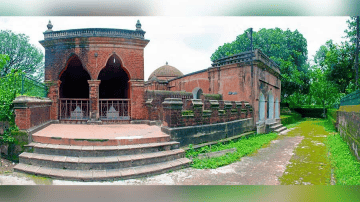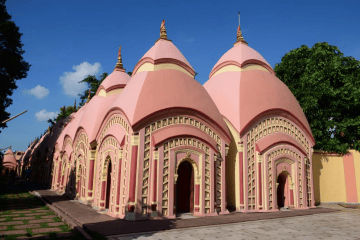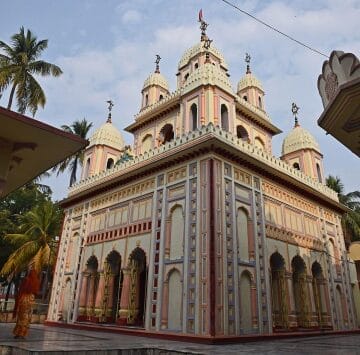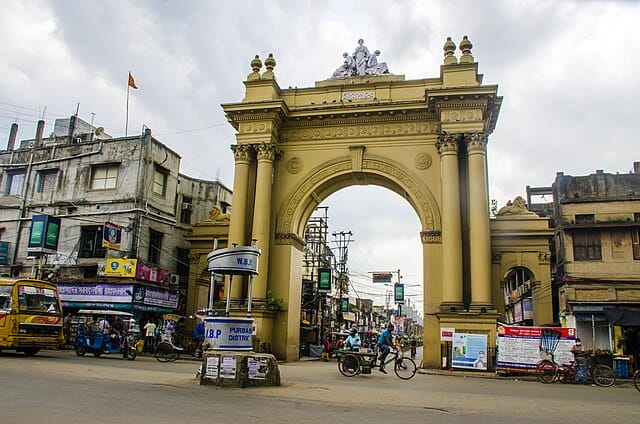Bardhaman town, renowned for its Bengali sweets like mihidana and sitabhog, is also famous for its rich tapestry of folk culture and heritage sites. The town has immense potential for tourism. But the question arises, how much of it has been explored?
This article aims to shed light on Bardhaman’s historical sites, the initiatives to promote tourism while addressing the civic issues hindering its progress, and highlight the need to balance tourism with sustainable development.
Heritage sites of Bardhaman

Sher Afghan’s tomb
Located beside Pir Beharam, close to Rajbati, lies the tomb of Sher Afghan, the resting place of the last Mughal Jaghirdars of Bardhaman. Ali Quli Khan Istaju, who was later bestowed with the title of Sher Afghan, served as the jagirdar in this important Mughal headquarters and was often regarded as the ‘Durgadhipati’ of Bardhaman. The tombs of Sher Afghan and Qutubuddin lie side by side beside the burial ground at Pir Beharam.
Sher Afghan’s tomb is maintained by the Archaeological Survey of India (ASI).

108 Shiva temple
The Aat Chala (four sloped roofs) of the Shiva Temples is an architectural marvel. They are usually found in clusters 2 to 108. Two such clusters of 108 Shiva Temples are in the heart of Bengal, routinely bustling with pilgrims.
This enormous complex of 108 Shiva Temples in Nababhat, Bardhaman, was erected by Maharani Bishnu Kumari Devi of Bardhaman’s royal family in 1788. The dilapidated structure was renovated by the Birla Jana Kalyan Trust in 1965. Currently, 108 Shiv Mandir Trust Board has been entrusted with its maintenance. The board has undertaken a project of building a guesthouse for devotees. In 2013, West Bengal Tourism Department allocated a fund for constructing a parking lot in front of the temple complex and building a picnic spot next to it. Every day, hundreds of visitors and history enthusiasts flock to the temple.
Nawab Bari
Popularly known as Nawab Bari, the Khwaja Anwar Maqbera, is a tomb built by Mughal Emperor Farrukhsiyar in 1718 in honour of Khwaja Anwar, the Amir of the governor of Bengal Azim-Us-Shan. Spreading over a vast expanse of land, this complex amidst lush vegetation comprises the burial ground of royal associates, and houses a triple dome mosque, a large pond with a pavilion at its Centre, commonly known as Hawa Mahal.
This dilapidated complex is now inhabited by Anwar’s descendants. Claimed as private property, the decrepit monument is not properly maintained.
Local resident Anima Laha says, “It upsets me to see the decrepit condition of this historical site. The Government must take immediate steps to revive this historical monument.” Several visitors say that this property should be transferred and looked after by the Archeological Survey India (ASI).

Sarvamangala Devi Temple
The shrine of Goddess Sarvamangala was commissioned by Maharaja Kirti Chand of Bardhaman in 1702. It is claimed that in 1740, Maharaja Chitra Sen Ray, the then king of Burdwan had dreamt of Goddess Sarvamangala asking him to rescue her idol found by a lime manufacturer near the bank of River Damodar and place her in a temple, assuring him that this would put an end to the invasion of Bargis, a Maratha community, who had been tormenting and squandering the regions of Burdwan, Birbhum and Bankura at that time. This resulted in the establishment of the present temple complex.
The Sarvamangala Devi Temple attracts devotees throughout the year, especially on occasions like Poila Baisakh (Bengali New Year).
The temple was looked after by the royal family of Bardhaman. But after the abolition of the Zamindari system in 1959, the last king of Bardhaman, Maharaja Uday Chand Mahatabh, handed down this responsibility to a Trust, constituting seven members led by the Chairman of Burdwan Municipality.
In 1994, the Trust Board renovated the temple, building a new ‘bhog ghar” (bhog- Prasad), and designed a garden with a fountain.

Curzon Gate
Upon entering Bardhaman through Grand Trunk Road, one is greeted with a view of the gigantic Curzon Gate, considered a landmark today. It was built for the coronation of the then king, Maharaja Bijay Chand Mahatab in 1902. It was inaugurated by Lord Curzon in March 1904 and hence was named in his honour. The gate consists of a central arch supported by eight Corinthian columns. Due to star shapes being embedded in the gate, it was initially named ‘Star of India’. The gate was renamed as Bijay Toron in newly independent India but is still locally referred to by its old name.
Other tourist spots
Some of the other popular tourists’ spots in Bardhaman are Science Centre, Meghnad Shah planetarium, Bardhaman Zoological Park, located in Golap Bag near Bardhaman University.
Bardhaman Science Centre was built in 1994 aiming to equip visitors with insightful knowledge in science and technology.
Government initiatives to preserve historical monuments
Nikhilesh Biswas, District Science Officer, claims, “Over the past few years, we have undertaken significant initiatives like in-house Museum Programmes and Museum Outreach Programmes, designed to engage both the general public and inmates. We have fostered close associations with several NGOs and schools for persons with hearing and speech impairment to expand our outreach and promote inclusivity.”
However, he adds: “Cleanliness is a major issue here, especially when there is an influx of tourists. To address this, we have a dedicated team of conservancy staff. As a part of our Swaachha Action Plan, every three months, we organise activities like plays to make visitors aware of the importance of cleanliness. When it comes to safety, being a central government organisation, tight security is prioritised here. The entire complex is under surveillance of CCTVs. Backpacks are checked before allowing visitors into the museum.”
Residents and tourists raise civic issues concerns
Rahul Rai, a local resident, says “The deteriorating condition of roads is a major issue here. Given the abundance of tourist spots, the roads in this area must be widened and dividers should be installed to facilitate smooth movement of vehicles and ensure safety of pedestrians.”
Pradyut Kumar Pal, a tourist says, “The road stretching from Rabindra Bhavan to Mohan Bagan is completely broken. The roads in this area, in proximity to schools, medical colleges and universities require prompt repair.”
Repaired roads will ensure a comfortable commute for students and tourists as well as seamless transportation of patients and ambulances. Waterlogging during heavy rainfall is another major issue here, posing difficulties to both residents and commuters.
Read more: It’s a struggle: Away from family, migrant workers from Murshidabad face unending challenges
Local vendors’ civic concerns
Sandhya Durlabh, a 58-year-old local tea-shop owner, laments, “There is no safety for my business. I cannot afford a pucca shop, so there is always a risk of theft. I wish the local authorities could help me build a pucca shop. The pathetic condition of the roads adds to my misery. During heavy rainfall, the roads get overflooded, and my shop and house get flooded. The roads are rarely cleaned. They only bother to clean them when political leaders and powerful people visit the area. Our requests are hardly paid any heed to unless party members ask them to do so.”
Tuntun Kumar Shaw, a 40-year-old nuts seller, says , “The roads are generally okay, but they should be cleaned regularly. Street lamps should be installed. After 5 pm, darkness descends, and I hardly get any customers. Installing street lamps will ensure pedestrian safety and increase commuters, giving me a better scope to enhance my livelihood. ”
Historian’s perspective
Shyam Sunder Bera, In-charge, Museum and Art Gallery- University of Burdwan, and the author of Bardhamaner Itikatha claims, “Tourism should be promoted keeping in mind that commercialisation and modernisation should never endanger the epochal eminence of the heritage spots. With the aim of commercialising historical sites and promoting tourism, the government entrusts the responsibility of preservation to private organisations with the tender. The historical grandeur of the heritage sites gets buried under the modernised cost-effective process of restoration.”
He adds, “The solution for this is consulting local historians and academicians and getting the public interested in this issue. Only if the authority, locals and academicians come together can we mitigate the problems affecting preservation and promotion of tourism.”
Balance between sustainable development and tourism
Though tourism leads to economic prosperity, creating a ripple effect that benefits numerous industries, it is crucial not to overlook the adverse impact of tourism.
1. Social inequalities: Unrestrained tourism development can displace local communities, disrupt their livelihoods, erode traditional cultures, hence contribute to social inequalities. Often, tourism development is only in the interests of higher strata people, culminating in exclusive development.
2. Infrastructure and carrying capacity: The influx of tourists can create chaos and worsen civic issues if infrastructure and accommodation are underdeveloped. Managing visitor flows, implementing effective transportation systems, and developing sustainable infrastructure are crucial in maintaining a balance between tourism promotion and sustainable development.
3. Environmental impact: Tourism can result in significant strain on natural resources, including land, water, and energy. Increased tourist activities can lead to habitat destruction, pollution, and the depletion of natural resources. Therefore, it is crucial to implement sustainable practices that minimise the environmental impact of tourism, such as promoting eco-friendly accommodations, encouraging responsible waste management, and supporting conservation initiatives. Strict rules and regulations should be enforced to ensure these rules are not breached.
Sustainable practices promoting harmonious coexistence of conservation of environment with the promotion of tourism, fostering effective cooperation among stakeholders, engaging in thoughtful planning, and promoting responsible tourism, will help Bardhaman town balance the multifaceted nuances of tourism. Only through such efforts can a suburban region like Bardhaman town fully harness its tourism potential while preserving its unique heritage for generations to come.
Earlier this year, Oorvani Foundation had collaborated with Youth ki Awaaz to host a Civic Journalism Training Programme, where young aspiring citizen journalists were encouraged to write about local realities. They attended discussions and workshops on governance, democracy, the roles and responsibilities of elected representatives (among other topics). This article is a ground report written by one of the participants from Bardhaman town in West Bengal.
Also read:
- Lok Sabha 2024: Know your MP — Abu Taher Khan, Murshidabad
- Madras Day celebrations and what it means for the city
- Travelling back in time along the Buckingham Canal